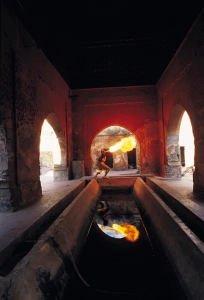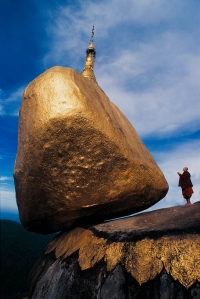Morocco has always been rather high on my list of countries to visit. Albert Watson’s remarkable book Cyclops embellished with its stochastic screen trio tone reproductions has wonderful photographs of the exotic and the fetishes of Morocco. Quite by chance recently, after sending a proposal for a book to an overseas organisation, they wrote back saying ‘Go to Marrakech’. Initially I thought that that phrase in German might mean go to hell or something equally discouraging but discovered that they were in fact talking travel. Very quickly I had to find out all I needed to know about Morocco. An Italian friend gave me an invaluable piece of advice, ‘ take hindi film audio, video cassettes, and film posters’ was his terse message. I did take some 35 current hindi film tracks, Dil to pagal hai and Hritek Roshan and that kind of thing.
Morocco is not connected to Mumbai easily for reasons that were going to become abundantly clear later on. You can get to Marrakech via Amman by Jordan Air with a stop over in Amman, great if you want to visit the Nabataen tombs and Treasury of Petra, Jordan is a beautiful country in any case, all air routes are via Casablanca of Bogart fame, but you will be disappointed with Casablanca, its name is far more romantic than the reality. From Casablanca you can fly to Marrakech via Air Moroc. I choose to go via Milan, Barcelona (Alitalia) and Barcelona -Casablanca- Marrakech by Air Moroc, only because I needed to firstly catch up with friends I met 22 years ago and I needed to photograph the Sagrada familia and other Gaudi architecture. I also needed to research Flamenco.
Morocco is on the north western coast of Africa on the Mediterranean. It is 8 km away from Europe, has been colonised by the French and only recently after India’s Independence got its own. But it has been at the cross roads of all kinds of trade and cultural exchanges between Europe and Africa and Asia for centuries before that. It has predominantly Berber (fair skin blue eyes) and Arab (brown skin, curly hair) influence. The languages spoken are Arabic and French. The Arabic is a dialect and different radically I’m told from that which is spoken in Arabia, but in Arabia they speak all kinds of dialects too. Since I attempt to speak a smattering of Arabic and French, no verbs please, we’re Indian, just nouns strung together with the infinitives, I sort of managed. The government has reaslised that French is not a doorway to the world (I wish the French would realise that too) and now teaches English as a second language in schools. In ten years time you will get by quite nicely in English. But I feel that language is a barrier and not a barrier if you are disposed to listening with your eyes, nose, skin and heart. My feeling is that the attempt one makes to understand people itself is the catalyst that opens wonderful insights. Translators have their place, sometimes very away from the actual photography. True you will not be able to discuss Hegel and Kant and Vivekanand, but there are many things where sheer observation is communication. Photography being the handmaiden of observation, photographers ideally should have little problem.
Morocco has a conservative islamic generation that is layered in the predominantly youthful, liberal population. It is not uncommon to see three generations of women, the grandmother in orange jelaba with veil up to the nose, the mother in printed jelaba, no veil and the daughter 20 something in tight trousers and figure hugging top, platform shoes, trendy shades and coiffured, full kissable lips, chewing gum and walking nonchalantly down the jamaal el Fna. The women are gorgeous and the men too, light eyes, olive complexion, crisp hair.
The covered souks are situated in the Medina, a generic term for an ancient (10th century) labyrinthine, Islamic habitation. The passages have typically high walls, close together (desert culture) no windows, just tiny doors where you have to stoop to enter. The doors are grungy and non discript but they can open into mind bending Riyads (private homes) that are ancient and fabulous with mosaic work and fine plaster reliefs. The Riyads all have a central courtyard and all the rooms open into this common meeting area, like our havellis in Rjasthan. Several Foreigners, including Albert Watson now have winter Riyads in the medina. Hermes the french silk scarf couturier has a home that has a mosaic swimming pool on the first floor and over the top artifacts on every square inch of wall, quite bewildering to behold. He has even managed to put in an elevator . All the homes in the medina have no more than one floor.
The food is great though being a born again vegetarian I could enjoy the smells of escargot soup and brain and organ transplant dishes. The salads and olives are just too delicious. Oranges fall from burdened trees on the ground to rot. It would be safe to assume that orange juice is cheaper than bottled water.
Everywhere in the medina I’d be accosted, hello Indian would be the common refrain. Indians and myself in particular can be mistaken for many other nationalities, Greek, Arab, Latin, Pakistani, Sri Lankan, Banglasdeshi. It would surprise me. when I mentioned this to a French colleague he remarked ‘frankly David you don’t look Norwegian’. So I guess I must look ‘Indian’. Then they would proceed with the roll call, Amitabh Bachaan, Sharouk Khan etc etc, reminding me of the days on the Bosphorus in Istanbul when during conversation it came up that I was from India, all other leads came to a grinding halt and all my host wanted to know about was Raj Kapoor and Nutan. One day at lunch the waiter made the now familiar discovery of my being Indian, and started with the litany of Bollywood stars to which I just nodded with my mouth making herbivorous gestures of stripping the olive flesh from the stones.Then on my way down he began singing ‘Aa Jaa Aa Jaa’. I had to turn around and give him a hug and promised the next day to give him a hindi audio cassette to update his repertoire.
In the souk I would ask people to do strange things for my photographs and they would oblige. Because of the heavy tourist exposure, the invariable tip in Dhirams would be solicited. I would say no Dhiram but would give away a hindi audio. Then the assistant at the shop came up to me and asked for a Sharouk Khan tape and I told him that when he would open his shop the following day at 9 am I would come by with the tape, to which he nodded with a disbelieving look that says I’ve heard this don’t call me I’ll call you. The following day I turned up as he was raising the shutter and handed out a cassette with SK on it. He took it but was not entirely pleased, he said no I want Sharouk Khan, Sharouk Khan, then I had to point out that the face on the cover was indeed Sharouk Khan, when he realised this he went running down the street with hands flaying wildly and screaming like a banshee in excitement. For the first time in my life I felt some respect for Bollywood and its ambassadorial role.
The Gnawa music of Morocco most closely resembles Soul. It has that blues quality that is distinctive. The musicians dance with a tassle on their caps kept twriling as they make rhythmic movements with their necks, its a dervish derivative and can be mesmeric.
Not many Indians pass through Morocco and this is why no flights go there directly. people are curious about Indians, kind of third world bonding. They would excuse me most generously for not being muslim. Everywhere I went people wanted to sit me down and over zillion cups of mint tea would want to know about my life and my country while invariably the light would get to that magic phase where everything is sublimated. Yes they were interested in selling me the odd kitsch, but were genuinely absorbed in discovering India. A very genteel people who despite their exposure to tourism and commercialism are not hard sell. There is more to Morocco than the Marrakech medina for sure and I will be back to photograph this ancient culture assimilating change yet holding on so organically to that which makes it unique.

